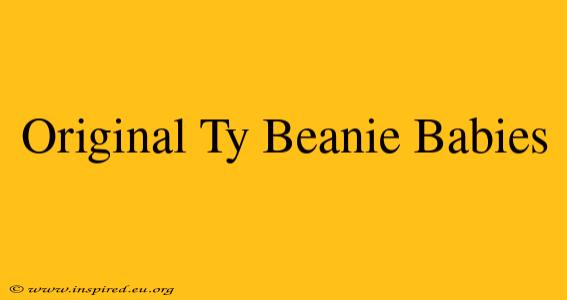Introduction:
Ty Beanie Babies, those plush toys with the iconic heart-shaped tag, swept the nation in the 1990s. Millions were sold, fueling a craze that transformed these seemingly simple stuffed animals into a cultural phenomenon and a potentially lucrative investment for savvy collectors. This guide delves into the world of original Ty Beanie Babies, exploring their history, identifying valuable pieces, and providing tips for collectors. Understanding the nuances of these original toys is key for anyone looking to enter this collectible market.
The Rise of a Phenomenon: Ty Beanie Babies History
H2: From Humble Beginnings to Nationwide Craze
The story of Ty Beanie Babies begins with Ty Warner, the founder of Ty Inc. He launched the first Beanie Babies in 1993. The initial designs were simple, featuring charming animals with stitched-on faces. Their unique design, coupled with clever marketing, quickly caught the attention of consumers.
Word-of-mouth marketing, coupled with a limited production and scarcity strategy, propelled their popularity. The introduction of the "error" and "retirement" concepts further fuelled the craze. These elements of mystery and exclusivity increased their perceived value.
H2: Identifying Original Ty Beanie Babies
H3: Key Features of Early Beanie Babies
Distinguishing authentic original Ty Beanie Babies from counterfeits is crucial. Genuine originals possess specific characteristics:
- Hang Tags: Pay close attention to the hang tags. Early tags often featured different styles and materials. Look for inconsistencies or imperfections—some are more valuable due to printing errors or variations.
- Swing Tags: These tags typically include the Beanie Baby's name, birthdate, and poem. Variations in these tags exist, and certain versions are highly sought after.
- Tush Tags: Located on the rear of the toy, this tag includes a series of numbers and letters to identify the manufacturer, year, and factory location. The tush tag's condition is just as crucial to authenticity as the swing tag.
- Stitching and Materials: Original Beanie Babies are often made from high-quality materials. The stitching should be neat and consistent.
- Rarity and Errors: Certain Beanie Babies are more valuable due to their rarity, production errors, or misprints. Researching these variations is a key component of successful collecting.
H2: The Most Valuable Original Beanie Babies
H3: The "Holy Grail" of Beanie Babies:
While values fluctuate, some Beanie Babies consistently command high prices. These highly sought-after Beanie Babies include (but are not limited to):
- Princess Diana: A tribute Beanie Baby released after the Princess's death. It is one of the most talked-about rare Beanie Babies, even for casual collectors.
- Patti the Platypus: One of the most sought-after error Beanie Babies. Collectors love the rarest and most coveted error babies.
- Claude the Bear: Released in a limited number, Claude's rarity drives up his price. Some versions have become increasingly rare and valuable over the years.
- Peanut the Elephant: The peanut Beanie Baby is another highly desirable item, with some values reaching the thousands.
- The "Errors": Many Beanie Babies with misprints or manufacturing errors have skyrocketed in value. These variations are often the most treasured items for experienced collectors.
H3: Factors Affecting Value
Several factors influence the value of a Beanie Baby:
- Condition: The overall condition, including the tag and the plush itself, is paramount. A mint-condition Beanie Baby in its original packaging commands a higher price than a worn one.
- Rarity: Beanie Babies with limited production runs or unique features are naturally more valuable. The rarity of certain Beanie Babies is part of their enduring appeal.
- Demand: The market demand for specific Beanie Babies directly impacts their value. Popular characters or those associated with significant events are highly sought after.
Investing in Original Ty Beanie Babies: A Collector's Perspective
H2: Is it a Good Investment?
While many associate Beanie Babies with investment opportunities, their value fluctuates significantly. It's crucial to approach collecting as a hobby, rather than solely as an investment strategy.
H2: Tips for Building Your Collection:
- Research: Thoroughly research the Beanie Babies you are interested in. Identify their value, rarity, and authenticity.
- Authentication: Be cautious about purchasing from untrusted sources. Verify authenticity before buying.
- Storage: Proper storage is crucial to maintain the condition of your Beanie Babies. Keep them in a cool, dry place, away from direct sunlight.
- Patience: Building a valuable collection takes time. Don't rush the process.
Conclusion:
Original Ty Beanie Babies represent a significant piece of 90s pop culture. While their value can vary, collecting them can be a rewarding hobby for enthusiasts. By understanding the history, identifying key features, and exercising caution, collectors can build a cherished and potentially valuable collection of these iconic plush toys. Remember to approach collecting with passion and a keen eye for detail. The world of original Ty Beanie Babies awaits!
